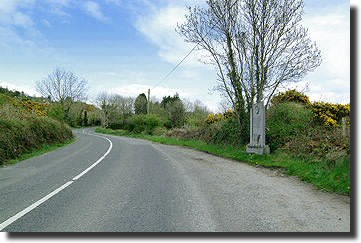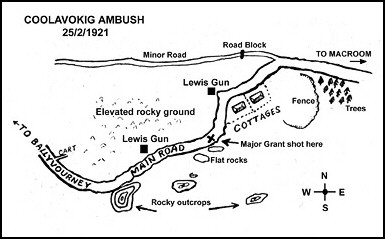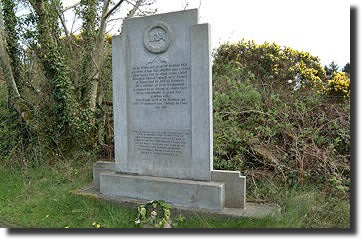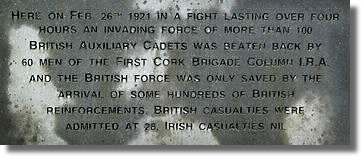|
Victory For I.R.A. at Coolnacahera Ambush (Irish War of Independence - First Cork Brigade)
|
|
Coolnacahera
(also
known as Coolavokig) situated
on the
road between Macroom and Ballyvourney was the scene, on a cold February day in
1921, of a fierce four-hour engagement between units of the First Cork Brigade,
led by Sean O'Hegarty, O/C and eight lorry-loads of Auxiliaries from the
Macroom garrison. The position was ideal as the site for an ambush.
North of the road, the stony hillocks and high masses of boulders provided
secure positions for the attackers. High outcrops of rock commanded wide fields
of fire over a few hundred yards of barren ground, broken only by a very low
loose-stone fence at the roadside. To the north, south and to the west rugged
countryside provided safe routes of withdrawal. As the location of a
well-prepared ambush, Coolnacahera
held all the elements of a death-trap for an unsuspecting convoy-provided that
the convoy was not too large or its vehicles too widely spaced to be contained
within the three or four hundred yards of roadway dominated by the surrounding
rocks. If the position had any disadvantage, it lay in the existence of two
cottages that stood beside the road at the eastern end of the ambush site and
at the edge of a small grove of trees. The danger of crossfire with the
positions north of the road also counted against occupation of one of the
cottages. The Macroom based Auxiliaries were in the habit of
making frequent journeys over the road to Ballyvourney. Piecing together the
reports from his intelligence agents in the town and from observers on the
route, in addition to the observations made by himself and by his staff, the
brigade O/C noted that the enemy never left Macroom before Sean O'Hegarty and the brigade and battalion
officers hoped to capture a large quantity of much needed arms and ammunition
at Coolnacahera. The column comprised sixty riflemen drawn from the second,
seventh and eighth battalions. It had also two Lewis light automatics and
approximately sixty men armed with shotguns. It could well be that the
achievement of complete victory at Coolnacahera
would add fifty or more rifles and, perhaps, a Lewis gun or two to the column
equipment. The placement of the various sections was decided on, and the hour
for the occupation of the ambush position was fixed at dawn on February 18.
The main body of the fighting force went into
carefully planned positions off the high rocky ground north of the road. At the
Macroom end of the position one of the Lewis guns commanded a field of fire to
the east and also to the west on the road below. At the western end the second
Lewis gun, mounted in a declivity high in the rock wall, dominated the road
towards the east for a distance of a few hundred yards. This Lewis gun was
protected by a section of riflemen which was in a position to cover the road to
the east and to the west. Further west, another section of riflemen protected
the flanks. Here a cart, which was out of view of the road, was ready to be
pulled across it, at a moment's notice, to form a temporary road-block which
would prevent enemy vehicles from driving out of the ambush position. At the
eastern or Macroom end a Section of riflemen was in position around the first
Lewis gun. This section also covered a road block on a minor road which ran at
the northern rear of the position. The minor road connected, farther to the
east, with the main road, and the road-block with its covering sharpshooters
was designed to prevent the enemy's use of the minor road from which the column
could be taken in the rear. Men armed with shotguns were disposed in support of
the rifle-men and also occupied posts as flankers. To the south, sections of
the Macroom battalion, under Commandant Dan Corkery, occupied two big rocky
outcrops which commanded a long stretch of the central position of the ambush.
Corkery's sections were also well placed to prevent the deployment of an enemy
force to the south. The Macroom men were positioned so as to pin an enemy force to
the more or less open road where it would be exposed to the heavy fire of Lewis
guns and rifles from the high rocky ground to the west, north and east. Away to
the south, on top of Rahoonagh Hill, an observation post was manned by
flag-signallers. The signallers had a view of the road to the east, towards
Macroom, for about four miles. To the west, they could see for most of the two
miles to Ballyvourney.
The men of the column lay among the rocks. Rural
and city men, they lay quietly at their posts. Jamie Moynihan from Coolea,
beyond Ballyvourney, was at the western end. Up on the rock, Hugh O'Sullivan
lay behind his Lewis gun and looked down the road. He could see where the road
turned slightly towards the south at Twomey's and Cronin's cottages and then
dipped into the little grove of trees. The men around Hugh O'Sullivan could see
the Macroom riflemen and shotgun men on the rocks to the south. The Brigade
O/C, Sean O'Hegarty, was at his Command Post above the road and to the north of
it. Between him and the western Lewis gun was Dan Sandow" Donovan from It was the same on the 19th and during the mornings
and days that followed. On the night of the 24th the Column marched away from
the ambush position. Next morning they were back again. Shortly after Slowly the enemy vehicles moved forward. Slowly and
warily they crawled on while their occupants scanned the roadside. Another
hundred yards would bring them well into the ambush position. No shot came from
the waiting column men. They wanted the enemy in the trap. But some of those in
the lorries began to dismount. No.1
section then opened fire. The Lewis gun stuttered with deadly effect from the
west. Civilian hostages were ordered out of the lorries by the Auxies and
forced to advance up the road. I.R.A. marksmen picked off the Auxiliaries. The
Lewis gun at the eastern end of the ambush opened up once more and then jammed.
It was not heard again. The occupants of five lorries were now engaged in the
fight. East of the crossroads more lorries were halted. Auxiliaries jumped from
them and occupied positions by the roadside, but they did not advance and they
were not in the fight. On the road west of Twomey's and Cronin's cottages
Auxiliaries and hostages dived for cover by the roadside. The riflemen of the
column kept picking off Auxiliaries. Quite a number of them were either dead or
dying. Many were wounded. The enemy fought back. Lead spattered off the rocks
on which the Column men lay. The western Lewis gun, manned by Hugh O'Sullivan,
was taking a deadly toll, but the other I.R.A. Lewis gun was a dead loss.
Auxiliaries crawled along the roadside and fired up at the rocks. Some of them
tried to take cover from the stone fence south of the road, but the fire of the
Macroom men out on the outcrops drove them back on to the roadway. East of the
crossroads, and well out of the fighting zone, one of the lorries succeeded in
turning and it was driven back to Macroom. Heavy British re-inforcements could
be expected.
Major Seafield Grant of the Auxiliary Division
stood on the road trying to mark down the I.R.A. positions so that he might
direct the fire of his men and order any flanking movement that might be
possible. Presenting a proud if foolhardy example, he ignored the
flying lead and the death that was taking place around him. An I.R.A. sniper
marked him down and shot him dead. Leaving their fallen chief, the other
Auxiliaries sought refuge in the cottage plots that sloped from the road
towards the south. The men of the Macroom Sections out on the outcrops of rock
drove the Auxiliaries from the cottage plots. They drove them up and into the
two cottages. Earlier, two of the enemy had tried to climb up to the position
occupied by No. 1 section. They were
shot down. Out on the south-eastern flank a number of the enemy tried to
outflank the Macroom flankers. Ned Neville, and his men wiped out the most
daring of the out flankers and the others withdrew. The survivors of the long fight on the road now
retreated into the two cottages, taking with them a number of hostages. The
I.R.A. Sections from the south and those who moved down from the west prevented
the enemy from the east from coming to the aid of the Auxiliaries in the
cottages where they were besieged by the remaining Sections. No. 1 section
opened a heavy fire on the front door and windows of the western cottage. The
Ballingeary, Coolea, and Kilnamartyra men were now deployed from the western
end of the ambush position and an attempt was made to completely encircle all
enemy forces in the immediate area of the ambush. What Auxiliaries could manage
to do so, had taken refuge in the two cottages. The fences commanding the
eastern cottage were still under the fire of the enemy to the east of the
ambush, but those inside both cottages began to burst loop-holes through the
walls. This was a fatal move in the situation in which they then found
themselves. The loop-holes provided ready-made targets for the I.R.A. riflemen,
and several of the Auxiliaries in the cottages died from the heavy fire poured
in through their own loop-holes. The Ballingeary, Ballyvourney and Coolea men,
with the Macroom sections, now moved up to the south of the cottages and a
withering fire, from the Lewis gun and rifles, was directed on the rear window.
At the front of the cottage, Auxiliaries who made dashes to gain the doorway
were shot down in their tracks. The fight was now raging fiercely. The I.R.A. fire
on the cottages grew more intense as that of the trapped men inside became
weaker. It was clear that the end was not far away. The attacking sections
moved in for the kill or the surrender-it had to be one or the other. The fire
of the defenders was dying out. Victory was at hand for the column which had
waited so long and so patiently. Suddenly there was a shout of warning. A long
line of lorries was approaching from Macroom. Some observers counted almost
forty vehicles. Reinforcements were arriving in great strength. It was now twelve noon. The fight had commenced shortly
after eight o'clock. The signal to withdraw was given and the sections had no
option but to pull out just as complete victory was within their grasp. The
order was to withdraw to the north-west and it was executed by all but No. 4
Section which lay south of the road. Unaware of the fact that the other
sub-units of the Column were withdrawing, the men of No. 4 Section continued to
man their posts. The newly arrived enemy had rapidly deployed and now these
fresh troops attempted to outflank and encircle the column. No. 4 Section
fought back stubbornly although somewhat mystified by the lull in the firing
from the north and by the renewed resistance from the Auxiliaries in the
cottages. They next heard firing to the north-west where the withdrawing
sections were now fighting a brief rear-guard action as hundreds of reinforcing
troops from Ballincollig and Cork tried to move up on them and encircle them.
Fighting skilfully, the section pulled out of its position and later succeeded
in reaching the assembly point at Coomachloy far to the north-west. At Coomachloy members of the column who had
withdrawn from the ambush were about to sit down to a meal in a farmhouse at
which they believed they were safe from any encircling British troops when two
lorries, containing troops from Killarney, approached along the mountain road.
The I.R.A. men grabbed their arms and, taking up a defensive position on the
mountainside, they fought a sharp engagement with the troops who, it
transpired, had lost their way and had simply stumbled on the men of the column
about to face their first taste of food since breakfast very early that
morning. With the arrival of No. 4 section the British withdrew after suffering
two casualties.
The reinforcements which arrived at Coolnacahera, barely in time to prevent
the surrender or death of the Auxiliary survivors of the ambush, were but part
of the force employed in a huge round-up ordered for that day. Troops were
drawn from Ballincollig, Cork city, Killarney, Bandon, and other posts.
Clearly, the British had been forewarned about the presence of the waiting
column at Coolnacahera, and their
plan included the sending of the heavy Auxiliary force from Macroom at the
early hour of eight o'clock, when it was scarcely daylight, together with the
employment of hundreds of troops in a huge encircling movement all over the
Muskerry area. The mission of the Auxiliaries, apparently, was to pin down the
first brigade column until the encircling forces moved in to ensure that it was
well and truly trapped. Whatever may have been the reasons for the British
failure to press home the advantages of superior numbers and arms, the fact
remains that the I.R.A. column did not suffer a single casualty whilst the
Auxiliaries at Coolnacahera lost
two commissioned officers, Major Grant and Lieutenant Sodie, and fourteen other
ranks. In addition to the sixteen who died, a further eighteen were wounded. |
|
|




